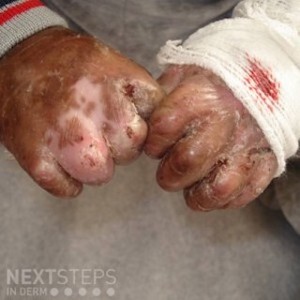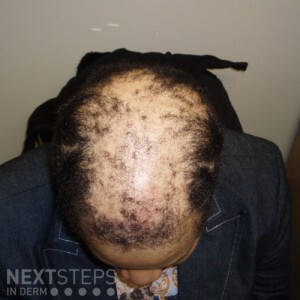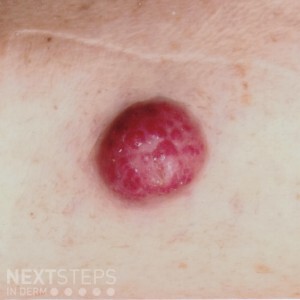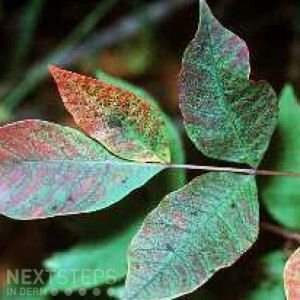Epidermolysis Bullosa – Friday Pop Quiz 11/8
822782278227 The picture shown is considered to be diagnostic for what type of epidermolysis bullosa:
A. Junctional epidermolysis bullosa- Non Herlitz type
B. Junctional epidermolysis bullosa- Herlitz type
C. Dowling-Meara form of Epidermolysis Bullous simplex
D. Dominant dystrophic epidermolysis bullosa
E. Recessive dystrophic epidermolysis bullosa
To find out the correct answer …
The picture shown is considered to be diagnostic for what type of epidermolysis bullosa:
A. Junctional epidermolysis bullosa- Non Herlitz type
B. Junctional epidermolysis bullosa- Herlitz type
C. Dowling-Meara form of Epidermolysis Bullous simplex
D. Dominant dystrophic epidermolysis bullosa
E. Recessive dystrophic epidermolysis bullosa
To find out the correct answer …
 The picture shown is considered to be diagnostic for what type of epidermolysis bullosa:
A. Junctional epidermolysis bullosa- Non Herlitz type
B. Junctional epidermolysis bullosa- Herlitz type
C. Dowling-Meara form of Epidermolysis Bullous simplex
D. Dominant dystrophic epidermolysis bullosa
E. Recessive dystrophic epidermolysis bullosa
To find out the correct answer …
The picture shown is considered to be diagnostic for what type of epidermolysis bullosa:
A. Junctional epidermolysis bullosa- Non Herlitz type
B. Junctional epidermolysis bullosa- Herlitz type
C. Dowling-Meara form of Epidermolysis Bullous simplex
D. Dominant dystrophic epidermolysis bullosa
E. Recessive dystrophic epidermolysis bullosa
To find out the correct answer … Continue reading "Epidermolysis Bullosa – Friday Pop Quiz 11/8"


 Here are the highlights for the November issue of JDD, which has a special focus on lasers, light sources, and devices.
Facial Skin Tightening With Microfocused Ultrasound and Dermal Fillers: Considerations for Patient Selection and Outcomes reviews of the application of microfocused ultrasound in combination with injectable dermal fillers as a treatment approach for lifting skin on the neck and …
Here are the highlights for the November issue of JDD, which has a special focus on lasers, light sources, and devices.
Facial Skin Tightening With Microfocused Ultrasound and Dermal Fillers: Considerations for Patient Selection and Outcomes reviews of the application of microfocused ultrasound in combination with injectable dermal fillers as a treatment approach for lifting skin on the neck and …  The best diagnosis of this type of cicatricial alopecia shown in this image is:
A. Chronic cutaneous lupus erythematosus.
B. Lichen planopilaris
C. Central centrifugal cicatricial alopecia
D. Pseudopelade of Brocq
E. Alopecia mucinosa
To find out the correct answer and read the explanation, click here.
Brought to you by our brand partner Derm In-Review
…
The best diagnosis of this type of cicatricial alopecia shown in this image is:
A. Chronic cutaneous lupus erythematosus.
B. Lichen planopilaris
C. Central centrifugal cicatricial alopecia
D. Pseudopelade of Brocq
E. Alopecia mucinosa
To find out the correct answer and read the explanation, click here.
Brought to you by our brand partner Derm In-Review
…  Biopsy of this lesion reveals a poorly-defined dermal mass of small blue monomorphic round cells with scant cytoplasm and nuclear molding. Which histologic stain is most helpful in distinguishing this lesion from small cell lung carcinoma?
A. CK20
B. TTF-1
C. Chromogranin
D. Synaptophysin
E. Somatostatin
To find out the correct answer and read the explanation, click here.
Brou …
Biopsy of this lesion reveals a poorly-defined dermal mass of small blue monomorphic round cells with scant cytoplasm and nuclear molding. Which histologic stain is most helpful in distinguishing this lesion from small cell lung carcinoma?
A. CK20
B. TTF-1
C. Chromogranin
D. Synaptophysin
E. Somatostatin
To find out the correct answer and read the explanation, click here.
Brou …  Match the photo to the plant identified:
A. Poison ivy
B. Gingko
C. Poison oak
D. Mango leaves
E. Poison sumac
To find out the correct answer and read the explanation, click here.
Brought to you by our brand partner Derm In-Review, a product of Sanovaworks.
…
Match the photo to the plant identified:
A. Poison ivy
B. Gingko
C. Poison oak
D. Mango leaves
E. Poison sumac
To find out the correct answer and read the explanation, click here.
Brought to you by our brand partner Derm In-Review, a product of Sanovaworks.
…